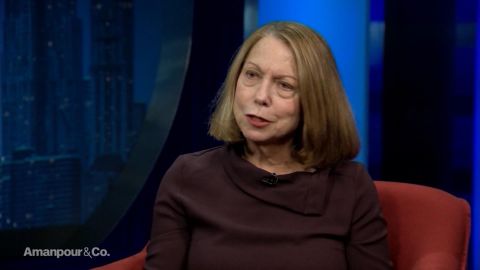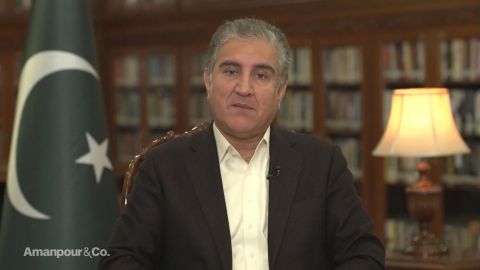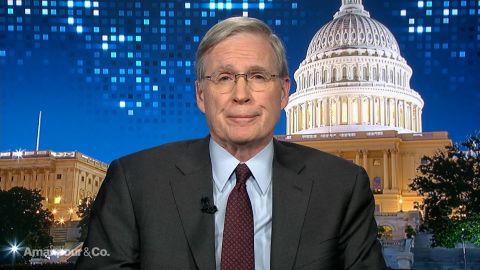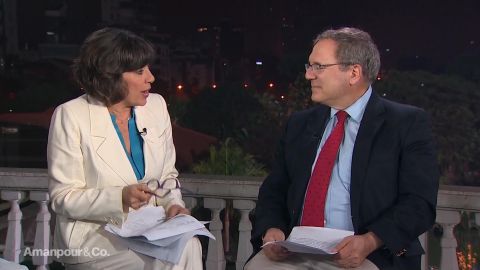Read Transcript EXPAND
CHRISTIANE AMANPOUR: And we’ll return now to a trailblazer for women in journalism and she is Jill Abramson. She served as the first female executive editor of “The New York Times”. And her new book, “Merchants of Truth” was supposed to be the definitive account of how the news business is evolving in the digital age. But its publication was marred by allegations of plagiarism and factual errors. And when our Walter Isaacson sat down with Abramson, he asked her to respond to the accusations and he also took a deep dive into her observations about the impact of the digital revolution on news.
WALTER ISAACSON: Jill, welcome to the show.
JILL ABRAMSON, AUTHOR, MERCHANTS OF TRUTH: Thanks so much, Walter.
ISAACSON: You’ve been accused of plagiarism in the book because a few passages that are pretty much verbatim from sources that weren’t cited well. My students that I teach would say, “OK, I’d get in real trouble for that.” Tell me the process you were using in which you took something out of another thing and you put it in and didn’t cite it. And what type of sort of technology were you using? Were you cutting and pasting?
ABRAMSON: I wasn’t doing that much cutting and pasting some. And — but I don’t think that in the — there are three examples of things that just went uncited, either authors or publications. I have 70 pages of footnotes and 835 separate citations. I was using a form of footnoting that I had never used before called “Trailing phrase” and was uncertain whether for — some people were angry because I credited some material but used other quotes from someone’s interview and didn’t do a separate endnote on that. I didn’t think that is what that form required. But looking back, I wish I had been more careful. And as you know, as a book author, the footnoting and citation is a little bit left towards the end. That’s, unfortunately, is fact-checking. In one case I know I looked at a long paragraph and saw that there should be a citation to “The Washington Post” which there is. But the top of the paragraph which flows right into that came from somewhere else and I failed to say that. And that was just sloppiness.
ISAACSON: But it wasn’t just a lack of citations. It was in three, four, five, six sentences, passages, sentences, two or three sentences that were almost verbatim from somebody else’s writing. I mean how did that happen? And this is a book about journalistic ethics. Shouldn’t you be careful enough not to just verbatim, take two or three sentences?
ABRAMSON: Yes, or put them in quotes in the text as preferable to a footnote. But I now wish I had put them all in quotations rather in citations. But the important thing as I wasn’t intentionally stealing anybody’s work.
ISAACSON: How much — how important is it whether it was intentional or not?
ABRAMSON: Well, I think it is important because I’ve — since this has become a controversy, I’ve talked to many people about how to define plagiarism and it’s sort of all over the map. But a number of professors have said to me there has to be sort of the venal intent. And they see what I did at the — as menial mistakes.
ISAACSON: Meaning sort of unintentional?
ABRAMSON: Yes.
ISAACSON: You weren’t trying to actually steal somebody’s words.
ABRAMSON: Yes.
ISAACSON: Even though you sort of changed a few words here and there but that was just inadvertent sloppy or is that sort of you trying not to use somebody else’s words?
ABRAMSON: No, it wasn’t the latter. I think I was just rushing through.
ISAACSON: You teach journalism some and you have a seminar on journalism.
ABRAMSON: Two.
ISAACSON: Two seminars on journalism. Issues you’ve gone through now on using other people’s material and plagiarism, is that a teachable moment? And have you figured out how to make that into something where you can look inside yourself and then share it with students?
ABRAMSON: I brought it up firsthand and we talked about it for — my seminar is three hours. We talked about it in one class for more than an hour and another for at least an hour. A teachable moment is such a cliche. I hate to use it. But it was important to me because obviously, academic plagiarism has been a big issue and every college you teach as well. And I wanted to explain to them exactly what had happened, how I could have done better. That I was disappointed in myself and sorry and that these were errors that were inadvertent, and that I regret completely. And I just had a good discussion with them.
ISAACSON: You write a lot about “Vice” and how “Vice” really helped reinvigorate the whole notion of news, does a lot of great reporting. And yet you also got a lot of pushback from the people at “Vice”. Tell me your thoughts on “Vice” and why there was so much pushback on the sections on “Vice” you wrote about in your book.
ABRAMSON: Well, my thoughts about “Vice” are similar to what you just said, that especially — I watch their HBO nightly news show, “Vice News Tonight.” And they don’t have an anchor. They don’t have correspondents doing standup very much. And their correspondents are young. Many of them are excellent. I mean their coverage of the Charlottesville Marches over the Confederate Statues were just amazing, long videos piece. Young people are not watching nightly news. They don’t watch appointment T.V., period. So they’re trying to reinvigorate news for a younger audience which is vital and important. I think I got pushback from them mainly because they thought there was a tone of snarkiness whereas like a media elitist. I was somehow looking down on them and saying they weren’t as good or as qualified as people at “The New York Times” or “The Washington Post”.
ISAACSON: One of the things in your book is sort of this notion that the ad-supported model of media isn’t going to sustain itself and that the two old institutions you write about, “The Washington Post” and “The New York Times” have actually turned out to be better than you would have expected when you began the book.
ABRAMSON: That was one of the interesting things about reporting and writing this book is that when I began it, I thought it was the shiny new digital upstarts, “BuzzFeed” and “Vice” that everyone was envious because they were full of very lucrative native branded advertise. They were really successfully using other platforms like Facebook and Google and getting a ton of both audience and because they had such big audiences, advertising. The world changed on them really in the past year and a half very sharply. And Facebook and Google are now taking for themselves like by far most of the digital advertising. And they’re not really sharing revenue to a significant or meaningful degree where it would support a company with the people who are supplying them with the news and video they put in people’s news feeds or that Google puts on YouTube channel. They are starving because advertising was their chief and single revenue source. And for the legacy newspapers, “The New York Times” and “The Post”, advertising for them was going this way in the newspaper. And that was their old chief form of revenue for decades.
ISAACSON: How did Arthur Sulzberger and A.G. Sulzberger, your former publishers when you were at “The New York Times”, how did they end up figuring it out?
ABRAMSON: Well, I think that they saw that it was just necessary that “The Times” needed to have more than advertising revenue to support its gigantic newsgathering operation. And in 2006, “The Times” had tried charging readers especially for opinion content than other kind of special material but it was called “Times select” and been a big flop. So yes, I think it was a combination of just needing the new revenue but being brave. It was a brave decision of Arthur Sulzberger Jr. to try it again. And lo and behold, it worked. I think the first month that they put a digital pay plan in, 300,000 people had taken them out. And it was chits cheap. I mean it’s still very cheap. I’m sure some of your viewers get those a dollar a week.
ISAACSON: Did Trump help?
ABRAMSON: Well, definitely Trump help. And, you know —
ISAACSON: The Trump bump?
ABRAMSON: That so-called Trump bump for sure. I mean “The New York Times” has gained millions of new digital subscribers since Trump’s election.
ISAACSON: Is “The New York Times”, either when you were the editor now sort of congenitally anti-Trump?
ABRAMSON: Well, “The New York Times” that I worked at was congenitally urban and cosmopolitan and reflecting the values and interests of people on the blue coast. And to that extent, I think the paper is and I think deservedly so. I think readers are so sort of interested and loving the toughness of “The Times” and “The Post” which some people do see as anti-Trump because the stories, our investigative stories, that are about questionable business dealings and how he acquired his wealth and his tax avoidance and you name it. I think — it’s in keeping with “The Times”, we’ve never seen a presidency like this and it is on an order of magnitude that’s different. And I think “The Post” and “The Times” have been emboldened to load their news reports up with stories about Donald Trump most of which are critical and they attract huge numbers of readers who want to read about Donald Trump. I mean I have friends at “The Times” who have said when they aren’t writing about Trump, chart eats numbers for their readership go down.
ISAACSON: Is “The New York Times” almost addicted to punching Donald Trump because it gets the traffic?
ABRAMSON: I mean I think they’re not the only ones. I think there is an addiction to Trump. And the comedian at the White House Correspondents’ Dinner a year ago made the joke to all of the journalists there, “I think you want to date him.” So it’s widespread. And “The Washington Post”, their posts most product has two or three — they’re not about Trump but they’re obvious clickbait stories. And you kind of can’t resist, they end in headlines like, “And you won’t believe what happened next”, which is straight out of “BuzzFeed”.
ISAACSON: You’ve covered for organizations. One of which is at “Times” where you worked. And I like the book how candid you were about your own turmoil as editor of “The Times”. Why were you fired?
ABRAMSON: It’s — why do you I wrote — why do you think I was fired?
ISAACSON: Well, you explained it a lot in the book but I was —
ABRAMSON: It doesn’t like boil down to a sound bite. And what I tried to do in writing about that painful passage of my career. It’s the only part of the book that isn’t a third person narrative, it’s first person. It’s be candid about my own failings as a manager. I’m a little bit about what I think is still gender double standard at many companies where a woman is criticized for being too pushy or assertive or other worse words. But there have been many studies that show that’s seen as leadership in men and that women’s likability goes way down when they get the top job. So there’s some of that. There was internal politics. There were concerns on my part about the lowering of the wall between the news and business sides of “The Times” in the digital era. And so it was a combination of things.
ISAACSON: Your book shows the excitement of things like “BuzzFeed” and “Vice” coming along with a whole new vitality. But recently, they’re the ones doing the layoffs.
ABRAMSON: Two hundred and fifty staffers each gone.
ISAACSON: And “The Washington Post” and even “The New York Times” are still staffing up.
ABRAMSON: I think “The Times” is up to 1,600 journalists. I mean that’s a big bump up from when I was executive editor.
ISAACSON: And do you think that this is a major turn or is it just one of those roller coaster things that’s happening?
ABRAMSON: I think that “The Times'” financial picture will outlast the Trump bump. Whether it can continue to support such a large staff of journalists and technologists and designers, I don’t know. Things go in cycles.
ISAACSON: But you look at “BuzzFeed” and you look at “Vice” and their business model hasn’t yet led them to be able to get revenue from the user, from the reader. Is that a fatal flaw?
ABRAMSON: I hope it’s not a fatal flaw. But I think that both of them are in real trouble right now and worried about the future. And Jonah Peretti has even tossed out a proposal that maybe some of these companies should merge and that that would create a path out of this very difficult moment.
ISAACSON: They seem to still have a pretty high valuation. Why is that?
ABRAMSON: Because they had crazy high valuation starting five or six years ago. It wasn’t that long ago that “BuzzFeed’s” valuation was like 1.7 billion and “Vice’s” was the highest of any digital media company and got to 6 billion. And I think for both of them, that meant the idea that there’d be a white knight coming to acquire them, that moment has passed too. They’re just too valuable. Their valuation is too big. Maybe the time will come that it’s like newspapers. I mean “The Time Spot”, “The Boston Globe”, and another — “The Whistler Paper” for $1.2 or $1.3 billion and sold the globe for 70 million. I mean so surprising things happen over not that long a ton.
ISAACSON: Thanks for being with us.
ABRAMSON: Thanks, Walter.
About This Episode EXPAND
Christiane Amanpour discusses the US-North Korean summit with New York Times National Security Correspondent David Sanger and former U.S. National Security Adviser Stephen Hadley. She also talks nuclear-rtension in India and Pakistan with Pakistani Foreign Minister Shah Mehmood Qureshi. Jill Abramson joins Walter Isaacson to discuss accusations of plagiarism plaguing her new book.
LEARN MORE



